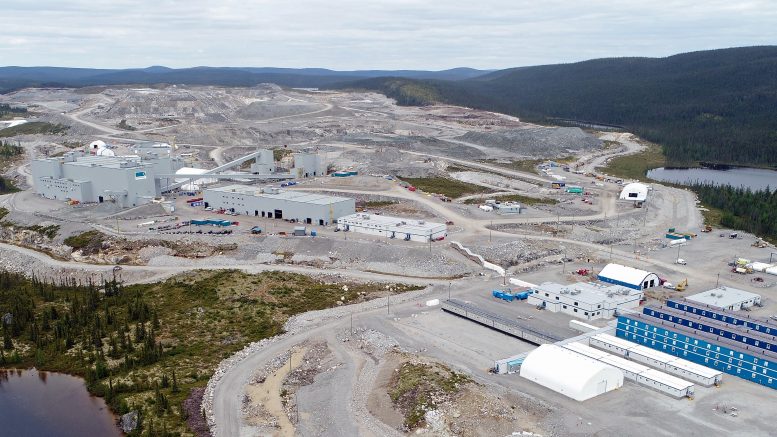It didn’t take long for Stornoway Diamond (TSX: SWY) to realize that it had a problem with diamond breakage at its newly built Renard mine, 360 km north of Chibougamau, Que.
While all diamond plants have some amount of breakage, the levels at Renard — which began commercial production on Jan. 1 and achieved nameplate production of 6,000 tonnes per day in June — were higher than expected.
“We’re breaking approximately 10% more than we expect, so we’re talking about a range of 20-25% breakage,” said Patrick Godin, Stornoway’s chief operating officer, in September.
The company had only predicted levels of 10-15%, so the higher breakage levels mean that smaller and lower-quality stones make up a larger share of production than anticipated — reducing overall revenues.
In the first half of the year, the company saw a modest improvement in breakage after it made a number of adjustments to the plant, such as adjusting crusher operating settings, material balancing, and minimizing ore and diamond recirculation.
But high levels of internal dilution in Renard ore — country rock gneiss which is much harder than kimberlite — meant that breakage levels were still unacceptably high in the secondary (cone) crusher and high-pressure grinding roll. The impact of the hard waste, which can vary up to 50-70% of mined material, against the diamonds and the steel linings in the crushers is a principal cause of breakage.
In response, the company announced a $22-million plan in August to install a 7,000-tonne-per-day TOMRA spectral sorting unit at the plant. The circuit, which is being installed after the primary jaw crusher and before the secondary cone crusher, will extract waste rock in the +30mm to -200 mm size range. It’s expected to be commissioned in the first quarter of 2018.
In an August conference call to discuss Stornoway’s second-quarter results, Godin said the company had done two series of tests that demonstrated the technology works very well to separate the waste from the ore, which are visually different.
Although the sorting technology has been used in industrial operations, Renard will be the first diamond mine to incorporate it. Asked about the risks of being the first diamond miner to use the technology, Godin noted that TOMRA spectral sorting equipment is widely used in mining.
“When we did our tests it was at high rates with equipment that was sized for the operation, not for a lab, so we are pretty confident we’ll be successful with this,” he said.
The new circuit, which will add about $1 per tonne in operating costs (currently running around $54 per tonne), can be expanded in the future. As it will remove about 35-40% of the waste, it also has the added benefit of opening up capacity in the back end of the plant.
Diamond market
Other than the breakage issue, Stornoway has reported that operations are running smoothly — mining costs have been in line with expectations and the orebody has delivered higher grades than expected (in the third quarter, grades were 12% above plan).
And after being initially cautious, buyers have warmed to Renard goods, said Stornoway president and CEO Matt Manson.
“Since the first sale last November, we’ve increased in real terms — looking through the mix, normalizing the mix, normalizing the quality assortment and the size distribution — by 19%,” Manson told Canadian Mining Journal in September.
Only about 3-6% of the increase has been due to a rise in the overall market, he added.
“We’ve had very good reports on yield, the amount of polished you can get out of the rough,” Manson said. “There’s no skins or coats on our goods — they’re very easy to assess when you pick them up and look at them and they’re very predictable when you polish them.
“After about 1 million carats of sale, we’ve only had one report of a diamond breaking on a polishing wheel.”
To the end of September, Stornoway had completed seven diamond sales (for a total of nearly 1.2 million carats), averaging US$81 per carat in the first quarter, US$87 per carat in the second and US$94 in the third. Due to several factors, including the breakage issue in the plant and market conditions, the company said its pricing figures would likely fall below its 2017 pricing guidance of US$100-132 per carat given earlier in the year.
In the second quarter, Stornoway reported net income of $2.3 million on revenue of $42.6 million. Renard is expected to produce 1.8 million carats per year over a 14-year mine life.
Stornoway has also been active on the exploration side: it recently staked three new properties based on a review of proprietary databases, with work programs planned for this year, after access permits are received.
The company discovered two new kimberlites at its Adamantin property 100 km south of Renard after a drill program completed in April. Diamond results are pending.
—With files from Canadian Mining Journal, October 2017. This story originally appeared in the November 2017 edition of Diamonds in Canada.


Be the first to comment on "Stornoway looks to spectral sorting at Renard"